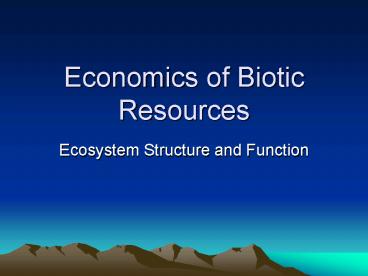Economics of Biotic Resources - PowerPoint PPT Presentation
1 / 28
Title:
Economics of Biotic Resources
Description:
What is the relationship between a species stock and it's ability to reproduce? ... Variation in Critical depensation: Passenger pigeons and Mauritius Kestrel ... – PowerPoint PPT presentation
Number of Views:128
Avg rating:3.0/5.0
Title: Economics of Biotic Resources
1
Economics of Biotic Resources
- Ecosystem Structure and Function
2
Important points to cover
- What is the relationship between a species stock
and its ability to reproduce? - Maximum sustainable yield (MSY)
- Minimum viable population, or critical
depensation, CD - What is a sustainable harvest from a given stock?
- What is profit maximizing harvest?
- From a static perspective (no investing of
profits) - From a dynamic perspective (we can invest
profits) - What is an optimal harvest?
- From an ecosystem perspective, when we account
for both the stock-flow and fund-service nature
of ecosystems - What is the impact of profound uncertainty on all
of this?
3
Econ of Ecosystem Structure Renewable stock-flows
- Material flow from a stock over time
- Can use stock as fast as we want
- Level of stock affects future flow
4
Sustainable Yield Curve
5
Carrying capacity, MSY and minimum viable
population (point of critical depensation)
- Uncertainty and dependence on exogenous variables
- Variation in Critical depensation Passenger
pigeons and Mauritius Kestrel - Critical depensation for ecosystems
6
Sustainable harvests and effort
What is the relationship to scale?
7
Harvest effort and cost
- Yieldcatchability quotient x Stock x
effortYqXE - Stable equilibrium
- Unstable equilibrium
- Where did historical harvests take place?
- Where are they taking place now?
8
The Total Revenue Curve
- Yield price Total revenue
- Multiplying every point on curve by same number
does not change shape of curve
9
Total cost for sustainable yields
- TPC total private costs
- As harvest goes up and stock goes down, what
happens to costs? - Rough transformation of YqXE for every level of
E - TPC represents the cost for the corresponding
sustainable yield
10
Profit maximization
- p TR-TC
- maximum p occurs when MR MC
11
Maximizing annual profit (static)
12
Open access fishery
- Non-excludable (no barriers to entry), non-rival
- What will happen if some fishermen are maximizing
profit?
13
Open access fishery
- Non-excludable, non-rival
- p 0
- This is what happens in any competitive market
- What happens when harvest costs are very low?
- What actually happens to harvest costs relative
to price over time?
14
Decrease in harvest costs
15
(No Transcript)
16
Profit maximization (dynamic)
- To move from one point on the sustainable
harvest curve to one at a lower stock, we must
reduce the stock. - What happens to the profit made by selling that
stock?
17
Opportunity Costs of Renewable resources
- The opportunity cost of not harvesting is equal
to the foregone earnings from not investing the
profits of that harvest. - In practical terms, we give less weight to the
future than to the present (discounting)
18
Whats more profitable, letting your redwoods
grow at 1 per year, or cutting them down and
investing the profits in the stock market at 7
per year?
19
Dynamic profit Max
20
Dynamic profit Max
- MRMC, but MR includes interest on revenue from
unsustainable harvest - Think about repaying a loan with the profits from
reducing the stock - What if the interest (discount) rate is very high?
21
Whats missing?
- Ecosystem services
22
Announcements
- Most of the assignments handed in had no names.
No name no assignment. - If you turned in an assignment with your names on
it and I was slow in getting it back, you have
until Monday to address my comments on your
final. - Work study position USSEE conference
23
Including the fund-service
24
Characteristics of optimal harvest
- Must account for stock-flow and fund service
- Discounting probably not appropriate, and
particularly inappropriate for fund-service
component - Higher stocks, lower harvests than static profit
maximizing stock and harvest - Must account for uncertainty
25
Summary
26
So how do we get there?
- Direct regulations
- Net size, roadless areas, etc.
- Seasons, protected areas
- Taxes (shift TC curve upwards)
- Tradable quotas
27
What is the relationship to distribution?
- Who benefits from ecosystem fund-services?
- Who benefits from the harvest of stock-flows?
- Who deserves profits from harvest of stock-flows?
28
Natural dividend from renewable resources































